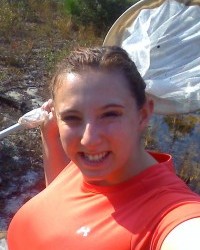Dr. Heather Arnett
Curriculum Vitae (click here)
I joined the Evolutionary Applications Lab (Kinnison Lab) in the Fall of 2010. Before joining the Kinnison lab I worked in the Climate Change Institute here at the University of Maine with the Saros lab to earn my Master’s of Science in paleoecology. My research there focused on pollution and nutrient loading in pristine lakes where we used algal community structure to recreate past environments. Before that I earned my Bachelor’s of Science from the University of La Crosse-Wisconsin in Honors Biology and Chemistry. My early research focused on mapping the life cycle of aquatic parasites in the Mississippi River and inducing inbreeding depression.
My dissertation research centers broadly around the complex mechanisms determining fish phenotypes and their implications for eco-evolutionary feedbacks in communities and ecosystems. Most work on eco-evolutionary dynamics has emphasized classical evolutionary trait change, but has not considered many of the other interacting processes shaping phenotypes in wild populations. My work utilizes several methods, including observational studies, experimental mesocosms, and experimental common garden techniques.
My research has explored three major components of phenotypic trait variation in mosquitofishes beyond classic population divergence: sexual dimorphism, phenotypic plasticity, and transgenerational trait effects (maternal effects and epigenetics). By understanding the scope for these sources of phenotypic trait variation through observational and experimental studies, I hope to foster a more integrated understanding of how various interacting components of trait change contribute to eco-evolutionary dynamics in nature. for example, in a recently published study colleagues and I showed how sex ratio variation and sexual dimorphism can contribute to the strength of trophic cascades. Several of my current projects consider predator exposure as a potential environmental cue shaping the morphological and behavioral responses of Mosquitofish to begin to understand 1) how phenotypes respond, 2) do they do so in a parallel or unique fashion for different sexes and species of mosquitofish and 2) for how many generations do exposure effects persist.
To learn more about my research or about me, check out my website!

